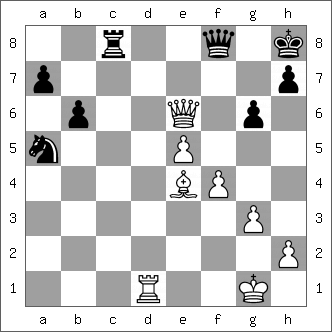Here's a theoretical novelty, played right here in Canada, from my 'why don't they play this?' file:
RA Fall Open (Ottawa), Round 1
5 Sept 2008
Classical Exchange Grunfeld D89
Kevin Pacey (2254) - Claude Carrier (2030)
1.d4 Nf6 2.c4 g6 3.Nc3 d5 4.cxd5 Nxd5 5.e4 Nxc3 6.bxc3 c5 7.Bc4 Bg7 8.Ne2 Nc6 9.Be3 0-0 10.0-0 Bg4 11.f3 Na5 12.Bd3 cxd4 13.cxd4 Be6 14.Rc1 Bxa2 15.Qa4 Bb3 16.Qb4 b6

17.Bf4!?
I came up with this theoretical novelty at the board. Normal is 17.Bg5 (or 17.d5 and 17.Rc3) 17...f6 (Preparing a little nest for the bishop on f7-Rowson) when White chooses between 18.Bh4, 18.Be3, and 18.Bf4. After the latter Black continued with 18...e5 19.Be3 exd4 20.Nxd4 Bf7 (Probably White has less than full compensation for the pawn-Rowson) in the game Kramnik-Shirov, Cazorla (m/1) 1998.
17...e5 18.Be3 exd4

19.Bxd4
Recapturing with the knight doesn't appeal to me quite as much in this situation, nor does it to Fritz. The bishop on b3 could safely withdraw to e6, with the bishop on g7 still enjoying an uncontested open diagonal. My chosen recapture allows White to play for a potentially favourable exchange of dark-square bishops.
19...Be6
Fritz suggests 19...Be5!?
20.Bxg7 Kxg7 21.Nd4

21...Qf6
Probably better is Fritz' 21...Nb7, permitting Nxe6+ in spite of splitting Black's kingside pawns. Now Black's queen acts for White like a red flag to a bull.
22.f4

22...Rfd8?
After this Black is probably just lost. Better was 22...Rfc8, keeping d8 open for Black's queen. Now she is soon driven completely offside, and White's queen gets to invade with effect.
23.e5 Qh4 24.Nxe6+ fxe6 25.g3 Qh6 26.Be4

By playing this before checking in with the queen, White keeps everything under control, since ...Rd2 is impossible.
26...Rac8 27.Qe7+ Kh8 28.Rxc8 Rxc8

29.Qxe6!?
Fritz' preference is 29.Qxa7, which may be safer.
29...Qf8 30.Rd1

30...Nc4??
Better was 30...Re8 31.Qh3 Qc5+ 32.Kg2 with a large advantage for White. Black decides instead to bring his knight back into the game, but there is no time.
31.Rd7

31...Nxe5
Despair. White threatened 32.Rxh7+! Kxh7 when 33.Qxg6+ mates.
32.Qxe5+ 1-0
RA Fall Open (Ottawa), Round 1
5 Sept 2008
Classical Exchange Grunfeld D89
Kevin Pacey (2254) - Claude Carrier (2030)
1.d4 Nf6 2.c4 g6 3.Nc3 d5 4.cxd5 Nxd5 5.e4 Nxc3 6.bxc3 c5 7.Bc4 Bg7 8.Ne2 Nc6 9.Be3 0-0 10.0-0 Bg4 11.f3 Na5 12.Bd3 cxd4 13.cxd4 Be6 14.Rc1 Bxa2 15.Qa4 Bb3 16.Qb4 b6
17.Bf4!?
I came up with this theoretical novelty at the board. Normal is 17.Bg5 (or 17.d5 and 17.Rc3) 17...f6 (Preparing a little nest for the bishop on f7-Rowson) when White chooses between 18.Bh4, 18.Be3, and 18.Bf4. After the latter Black continued with 18...e5 19.Be3 exd4 20.Nxd4 Bf7 (Probably White has less than full compensation for the pawn-Rowson) in the game Kramnik-Shirov, Cazorla (m/1) 1998.
17...e5 18.Be3 exd4
19.Bxd4
Recapturing with the knight doesn't appeal to me quite as much in this situation, nor does it to Fritz. The bishop on b3 could safely withdraw to e6, with the bishop on g7 still enjoying an uncontested open diagonal. My chosen recapture allows White to play for a potentially favourable exchange of dark-square bishops.
19...Be6
Fritz suggests 19...Be5!?
20.Bxg7 Kxg7 21.Nd4
21...Qf6
Probably better is Fritz' 21...Nb7, permitting Nxe6+ in spite of splitting Black's kingside pawns. Now Black's queen acts for White like a red flag to a bull.
22.f4
22...Rfd8?
After this Black is probably just lost. Better was 22...Rfc8, keeping d8 open for Black's queen. Now she is soon driven completely offside, and White's queen gets to invade with effect.
23.e5 Qh4 24.Nxe6+ fxe6 25.g3 Qh6 26.Be4
By playing this before checking in with the queen, White keeps everything under control, since ...Rd2 is impossible.
26...Rac8 27.Qe7+ Kh8 28.Rxc8 Rxc8
29.Qxe6!?
Fritz' preference is 29.Qxa7, which may be safer.
29...Qf8 30.Rd1
30...Nc4??
Better was 30...Re8 31.Qh3 Qc5+ 32.Kg2 with a large advantage for White. Black decides instead to bring his knight back into the game, but there is no time.
31.Rd7
31...Nxe5
Despair. White threatened 32.Rxh7+! Kxh7 when 33.Qxg6+ mates.
32.Qxe5+ 1-0


Comment